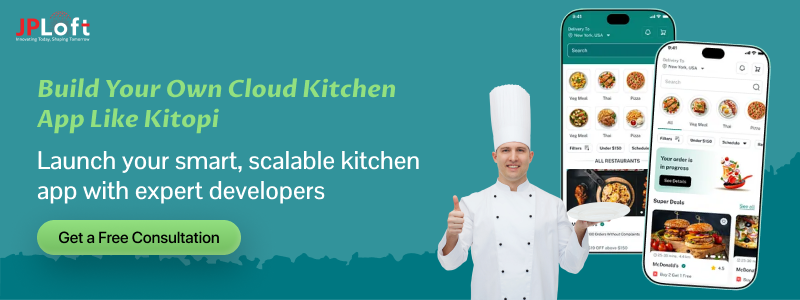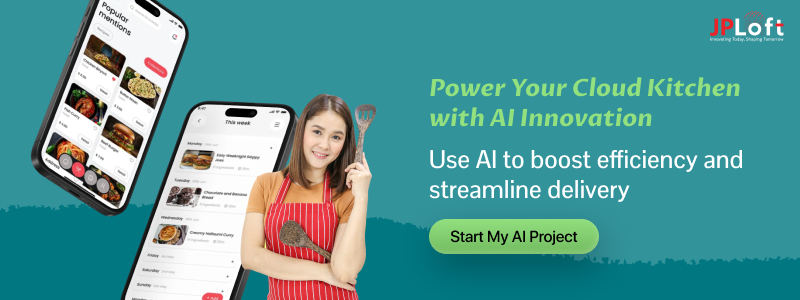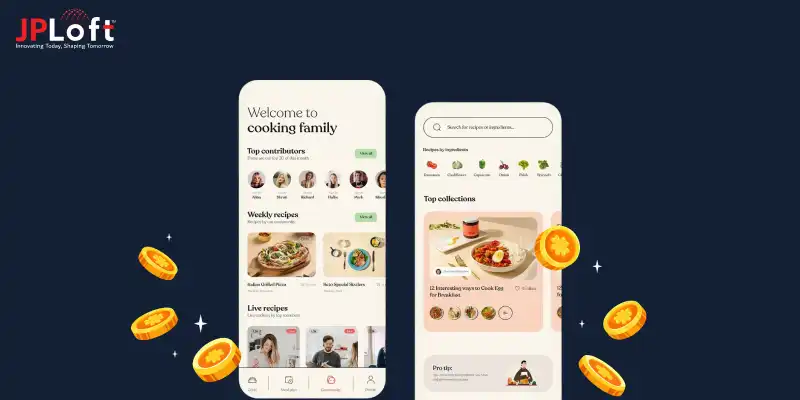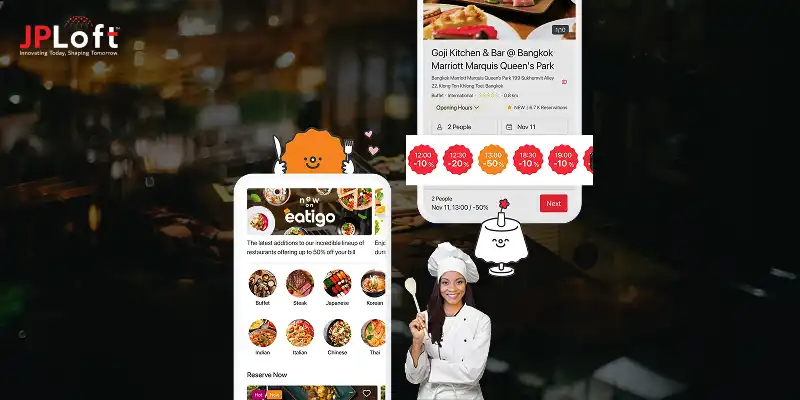Key Takeaways
Kitopi’s success lies in its data-driven cloud kitchen model, which merges technology, AI, and logistics to redefine food delivery operations globally.
Building an app like Kitopi requires a strong backend architecture, integrated delivery management, and AI-powered analytics for real-time decision-making.
The process to build an app like Kitopi involves in-depth research, intuitive UI/UX design, scalable backend development, and ongoing performance optimization.
AI integration enhances automation, predictive ordering, and kitchen efficiency, making it a game-changer for modern food tech platforms.
The cost to build a cloud kitchen platform like Kitopi varies based on features, complexity, and customization, generally ranging from $60,000 to $200,000, from basic MVPs to advanced AI-driven solutions.
JPLoft’s expert team can help you transform your cloud kitchen vision into a fully functional, scalable platform with cutting-edge technology and seamless execution.
The rise of cloud kitchens has revolutionized the food delivery industry, transforming how restaurants operate and how customers experience dining. Platforms like Kitopi have set a remarkable benchmark, offering a scalable, tech-driven ecosystem that helps restaurants expand without the heavy investment of physical outlets.
If you’ve ever wondered how to develop an app like Kitopi, this guide will walk you through every aspect, from app architecture and AI integration to cost, monetization, and future trends. You’ll gain a complete guide to make an app like Kitopi, understand its business model, and explore what it takes to replicate its success.
By the end of this blog, you’ll be equipped with a clear roadmap on how to create an app like Kitopi and confidently step into the booming cloud kitchen economy.
All About Kitopi App
Founded in 2018, Kitopi (short for Kitchen Operation Innovation) is a Dubai-based managed cloud kitchen platform that has redefined how restaurants scale their business. It partners with F&B brands to manage end-to-end kitchen operations from food preparation and packaging to on-time delivery. This unique model helps restaurants expand across cities without owning physical outlets, allowing them to focus entirely on brand growth and customer experience.
Unlike traditional restaurant models, Kitopi leverages automation, predictive data, and AI-driven systems to ensure operational efficiency. Its tech-first approach and seamless delivery network have made it one of the best restaurant apps and cloud kitchen platforms globally.
Kitopi’s success lies in its ability to blend cloud computing and culinary expertise, creating an efficient, scalable business structure. With over 200+ kitchens across multiple countries and a network serving millions, it’s now considered a benchmark for innovation in food tech.
If you’re planning to create a cloud kitchen app like Kitopi, studying its business structure can help you understand how technology and data automation fuel scalability.
According to reports, the global cloud kitchen market is projected to reach $141.08 billion by 2030, signaling a tremendous opportunity for startups planning to make an app like Kitopi and capture their share of this fast-growing digital dining ecosystem.
How Does an App Like Kitopi Work?
An app like Kitopi operates through a sophisticated blend of technology, logistics, and kitchen management to deliver seamless, on-demand food experiences.
It acts as the operational backbone for multiple restaurant brands, streamlining everything from order intake to delivery. Let’s break down how it works step-by-step.
1. Centralized Cloud Kitchen Network
Kitopi’s foundation lies in its centralized kitchen hubs, where multiple restaurant brands cook under one roof.
Each kitchen station is dedicated to specific cuisines, and orders are automatically assigned based on location, demand, and kitchen capacity.
This reduces operational costs and improves delivery times, a key reason why such models dominate today’s restaurant app development trends.
2. Real-Time Order Management System
The platform connects customers, restaurants, and delivery agents through a unified dashboard.
Orders from multiple food delivery platforms are automatically routed to the nearest available kitchen, where Kitopi’s proprietary system tracks every step — from meal preparation to dispatch.
This seamless integration between logistics and kitchen operations ensures real-time coordination, faster delivery, and improved operational accuracy across all connected touchpoints.
3. Smart Inventory and Supply Chain Automation
AI-driven inventory systems predict ingredient usage and reorder supplies automatically.
This not only minimizes waste but also ensures the kitchen runs at peak efficiency.
Kitopi’s predictive models analyze data like customer preferences, weather patterns, and delivery times to optimize procurement and reduce downtime.
4. Seamless User Interface and Experience
The frontend of a cloud kitchen app plays a massive role in user retention.
Clean layouts, easy navigation, and responsive designs form the backbone of an effective mobile app design strategy.
Kitopi’s interface provides real-time tracking, live updates, and personalized menus, ensuring customers stay engaged from order to delivery.
5. Automated Delivery and Partner Integration
Once an order is ready, the app integrates with delivery partners to dispatch it efficiently.
APIs and automated routing help assign the nearest available delivery agent.
Entrepreneurs aiming to create a mobile app like Kitopi can learn from its integrated logistics model, a combination of automation, smart routing, and real-time delivery tracking.
6. Data Analytics for Continuous Optimization
Every order, customer review, and delivery time feeds into a central data pool.
This helps Kitopi continuously refine its operations, improve delivery efficiency, and personalize experiences.
Predictive analytics also identify high-demand zones and forecast future trends, helping Kitopi expand strategically and maintain quality control across multiple locations.
Features to Include in an App like Kitopi
To make an app like Kitopi, you need to focus on innovation, scalability, and customer convenience.
Every feature must serve a purpose, whether it’s improving kitchen efficiency, simplifying delivery logistics, or enhancing user engagement.
Below are the must-have features that define a successful cloud kitchen app.
1. Multi-Restaurant Dashboard
This is the command center for managing multiple brands within a single app. The dashboard allows owners to monitor orders, track revenue, and analyze kitchen performance in real time. Advanced dashboards are one of the top restaurant app features, enabling smarter decision-making and transparency across operations.
2. Automated Order Allocation
Kitopi’s algorithm auto-assigns orders to the nearest available kitchen based on demand, delivery time, and food type. This ensures faster service and minimal wait time. It’s a great example for those researching how to create an app like Kitopi, as automation is key to operational success in this model.
3. AI-Powered Personalization
Modern apps rely heavily on artificial intelligence to create dynamic and personalized user experiences. Integrating AI in restaurant apps helps predict customer preferences, recommend dishes, and personalize promotions, just like Kitopi does. It enhances customer loyalty and increases repeat orders through intelligent menu suggestions and personalized deals.
4. Inventory & Supply Chain Management
Automated stock management tracks every ingredient used and predicts replenishment needs. This reduces wastage, ensures quality consistency, and saves significant manual labor costs. AI-backed systems make it possible for cloud kitchens to function with precision and speed.
5. Kitchen Performance Analytics
Real-time data dashboards provide insights into delivery times, average prep duration, and order volume. Analytics help business owners understand which items are popular and which need optimization. Entrepreneurs can draw inspiration from restaurant app ideas that use predictive insights to plan menu updates or streamline delivery routes efficiently.
6. Customer Feedback & Loyalty Integration
Building user trust is as essential as maintaining efficiency. Integrate in-app feedback, loyalty points, and personalized offers to keep customers coming back. These features improve satisfaction and long-term retention. If you’re working with a mobile app development company in the UK, ensure they design a loyalty system integrated with CRM analytics to keep your users engaged.
7. Smart Notifications & Marketing Automation
Push notifications and targeted promotions keep users updated on new deals, seasonal offers, and menu launches. Automating these processes boosts user engagement and helps scale marketing without additional manpower.
Feature Summary Table — Key Functionalities of a Kitopi-like App
|
Feature |
Description |
Purpose |
|
Multi-Restaurant Dashboard |
Manage multiple brands, track sales, and monitor performance in real time. |
Centralized control for cloud kitchen operations. |
|
Automated Order Allocation |
Auto-assigns orders based on demand, location, and prep time. |
Faster delivery and optimized efficiency. |
|
AI-Powered Personalization |
Uses AI to suggest dishes and offers based on user behavior. |
Improves engagement and repeat orders. |
|
Inventory & Supply Chain Management |
Tracks ingredients, predicts restock needs, and minimizes waste. |
Ensures consistency and reduces manual effort. |
|
Kitchen Performance Analytics |
Analyzes prep times, delivery rates, and order patterns. |
Enables data-driven decision-making. |
|
Customer Feedback & Loyalty Integration |
Offers in-app reviews, points, and personalized discounts. |
Boosts retention and customer satisfaction. |
|
Smart Notifications & Marketing Automation |
Sends targeted offers and updates automatically. |
Enhances marketing and user engagement. |
How to Develop a Cloud Kitchen Platform like Kitopi?
Building a high-performing, scalable, and efficient cloud kitchen app like Kitopi requires strategic planning, a robust technical foundation, and the right development team.
Below is a complete breakdown of the process to create a cloud kitchen platform like Kitopi, highlighting each critical stage that shapes the success of your platform.
Step 1: Define the Business Model and Target Users
Before diving into development, identify who your platform will serve, restaurant brands, kitchen operators, or delivery aggregators. Each segment comes with distinct requirements and operational goals.
Kitopi, for example, helps restaurants scale efficiently through managed kitchen networks. Having clarity on your target audience shapes your feature set, monetization strategy, and technical framework. Conducting detailed competitor analysis and mapping market needs early on helps you design a scalable, user-centric platform.
Step 2: Plan the Core Functionality
Every feature in a cloud kitchen app should solve a real operational challenge, from automating kitchen workflows to optimizing deliveries. Think about:
-
Centralized kitchen management
-
Smart menu configuration
-
AI-based order routing
-
Real-time inventory and delivery tracking
Focusing on these functionalities will help you build an app like Kitopi that balances user experience with business efficiency. Once the features are defined, you can move on to the next critical step: designing the user experience.
Step 3: Design the User Interface and Experience
The design phase defines your platform’s usability. A well-structured layout ensures that users, from restaurant partners to delivery agents, can navigate easily. Focusing on restaurant app design helps you prioritize intuitive interfaces, accessible dashboards, and simplified navigation for a seamless user journey.
Your design should also reflect your brand’s personality while making operations effortless for both restaurants and customers. Kitopi’s clean, modular UI is a great example of how thoughtful design can drive global success.
Step 4: Choose the Right Tech Stack
Selecting the right mobile app tech stack determines your app’s scalability and performance. For cloud kitchen apps, you’ll typically need:
-
Frontend: React, Flutter, or Swift for responsive interfaces
-
Backend: Node.js, Django, or Ruby on Rails for smooth operations
-
Database: PostgreSQL or MongoDB for reliable data management
-
Cloud Services: AWS or Google Cloud for scalability
-
APIs: Payment gateways, delivery partner integrations, and real-time tracking
This restaurant app tech stack ensures smooth data flow between users, kitchens, and delivery systems, forming the backbone of efficient and large-scale Kitopi-like app development.
Step 5: Develop and Integrate Core Modules
Once the tech stack is ready, start with modular development. Break the app into components such as:
-
Admin panel (for analytics and configuration)
-
Restaurant dashboard (for menu and order control)
-
Kitchen management system (for inventory and staff management)
-
Delivery agent app (for dispatch and route optimization)
Developing a cloud kitchen clone like Kitopi requires precision in how these modules interact. This phase also involves backend synchronization to handle thousands of concurrent orders efficiently.
Step 6: Integrate AI and Automation
AI is no longer optional; it’s the backbone of efficiency. From predicting demand to automating order dispatch, AI algorithms streamline every layer of operation. This ensures customers always get fast, accurate, and quality-driven service.
For entrepreneurs planning how to develop a cloud kitchen platform like Kitopi, automation is the secret to scaling profitably.
Step 7: Testing and Quality Assurance
Testing validates every feature, ensuring there are no bugs or performance issues before launch. This includes:
-
Functional testing
-
Performance and load testing
-
Integration and security testing
-
User acceptance testing (UAT)
Following structured restaurant app testing practices helps reduce launch-time risks, enhance app reliability, and deliver a consistent user experience, key factors that define long-term success.
Step 8: Deployment and Launch
Once testing is complete, the platform can be deployed across app stores and web platforms. But launch is only the beginning, collecting user feedback and monitoring post-launch analytics is equally crucial.
If you’re exploring how to launch a restaurant app on the app store, ensure a smooth rollout by optimizing app performance, fixing early bugs, and continuously iterating based on real-world insights.
Step 9: Maintenance and Updates
After launch, your development journey continues with ongoing updates, performance monitoring, and restaurant app maintenance to keep the platform secure and efficient. The right development partner ensures regular improvements, strong uptime, and modern features that keep users engaged.
Following these steps can help you make a cloud kitchen platform like Kitopi that’s efficient, scalable, and ready to compete in today’s digital food economy.
Use of AI in Building an App like Kitopi
Artificial Intelligence (AI) plays a transformative role in the evolution of cloud kitchen platforms.
Kitopi’s success is not just built on operations; it’s powered by intelligent automation, predictive algorithms, and real-time data analysis that optimize every step from order intake to delivery.
Below is a breakdown of how AI influences the process to develop a cloud kitchen platform like Kitopi, and how you can leverage it to achieve similar operational excellence.
1] Predictive Demand Forecasting
AI models analyze vast datasets from customer orders, regional trends, and time-based patterns to predict future demand. This enables kitchens to stock ingredients more efficiently and reduce food waste.
Understanding the role of AI agents in restaurant apps helps entrepreneurs identify how predictive models can maintain inventory accuracy and streamline logistics, two major pain points in cloud kitchen management.
Kitopi, for instance, uses machine learning algorithms that adjust kitchen operations dynamically based on upcoming demand spikes, weather conditions, and delivery partner availability.
2] Automated Order Management
AI enhances how restaurants receive, prioritize, and process incoming orders. Smart algorithms assign orders to the nearest available kitchen, minimizing delivery time.
This automation reduces human errors, ensuring smoother workflows and faster dispatches, crucial to maintain the consistency that platforms like Kitopi promise.
Moreover, integrating AI voice ordering in restaurant apps can simplify customer interactions by allowing users to place orders via natural voice commands. It not only improves accessibility but also provides valuable behavioral insights into user preferences.
3] AI-Driven Kitchen Operations
AI and IoT work together to transform manual kitchen workflows into intelligent, automated systems. For instance:
-
Temperature sensors monitor equipment performance.
-
AI predicts ingredient shortages.
-
Automated scheduling tools optimize staff allocation.
To build an AI app for a cloud kitchen, developers often integrate computer vision and machine learning modules that detect inefficiencies and recommend process improvements in real time. These intelligent systems drive both productivity and cost-effectiveness, especially in high-volume operations like Kitopi.
4] Personalized Customer Experience
AI enables hyper-personalization by analyzing user data, order frequency, cuisine preferences, and spending habits. This allows the app to recommend tailored meal options or suggest dynamic discounts.
For example, Kitopi leverages AI to create dynamic menu recommendations that adjust to local audience tastes, improving engagement and repeat orders.
Integrating these personalization models into your AI-powered restaurant system can dramatically improve user retention and lifetime value, two key metrics for cloud kitchen scalability.
5] AI-Powered Logistics & Delivery Optimization
Delivery is the heart of a cloud kitchen’s success. AI helps calculate the best delivery routes, manage real-time traffic updates, and allocate drivers efficiently.
Machine learning also assists in predicting delivery delays and automatically suggesting alternative routes.
Working with an AI app development company ensures seamless integration of these features, allowing your platform to maintain delivery precision even during peak hours.
6] Smart Data Insights and Decision Making
AI turns raw data into actionable insights. It helps restaurant owners monitor KPIs like order accuracy, average delivery time, and kitchen efficiency.
These insights empower brands to take data-driven decisions, optimize resource allocation, and enhance user satisfaction, ensuring your cloud kitchen app not only runs efficiently but also scales intelligently.
How Much Does It Cost to Make an App Like Kitopi?
The cost to build a cloud kitchen app like Kitopi typically ranges between $20,000 and $100,000, depending on the app’s size, design, features, and scalability goals. A basic MVP version with limited modules such as restaurant integration, order tracking, and delivery scheduling might cost around $20,000–$35,000.
However, a fully customized AI-driven version that mirrors Kitopi’s level of automation, including predictive analytics, voice-based ordering, and kitchen performance dashboards, can go up to $90,000–$100,000.. These variations depend on multiple factors, including design quality, technology stack, development region, and third-party integrations, all of which directly affect total project cost.
Factors Influencing the Development Cost
Here is a brief of factors impacting the overall cost to build a cloud kitchen app like Kitopi.
► Feature Set and Automation Level
The more advanced the features, such as real-time analytics, AI order allocation, and smart delivery management, the higher the cost.
Integrating automation to streamline food preparation and delivery requires additional development hours, but it also improves long-term ROI.
► Design and UI/UX Customization
A sleek, intuitive interface plays a major role in user retention. Investing in modern UI elements, motion effects, and seamless navigation helps your platform stand out in a competitive market.
Partnering with the best mobile app development company ensures your app maintains scalability while offering a polished, conversion-friendly interface that customers love.
► Technology Stack & Infrastructure
Your choice of backend frameworks, database systems, and APIs determines both scalability and performance. Using cloud-based hosting (like AWS or Google Cloud) allows real-time data syncs across multiple kitchens, crucial for Kitopi-style operations.
► AI and Machine Learning Integration
Advanced AI models for predicting order trends or optimizing delivery routes add to initial costs but lead to significant operational savings later. AI-driven personalization also enhances user satisfaction and retention.
► Geographical Factors and Development Team Location
Developer rates vary widely depending on the region. North America and Western Europe tend to be costlier, while Asia offers skilled teams at more affordable rates. For example, teams that understand how to build a restaurant booking app can often apply similar principles to cloud kitchen systems, optimizing costs while maintaining advanced functionality.
Estimated Development Cost Summary
|
App Type |
Estimated Cost (USD) |
Description |
|
Basic MVP |
$20,000 – $35,000 |
Core restaurant and delivery management features |
|
Mid-Level App |
$40,000 – $70,000 |
Enhanced UI/UX, order analytics, and customer management |
|
AI-Powered Kitopi-like App |
$80,000 – $100,000+ |
Predictive AI, smart routing, and automation capabilities |
In short, while the cost to build a cloud kitchen platform like Kitopi can seem high, the investment pays off through automation, efficiency, and scalability. Understanding these factors ensures you allocate your resources strategically and set a foundation for long-term success.
Monetization Strategies to Include in an App Like Kitopi
Building a successful app isn’t just about strong technology; it’s also about creating a sustainable revenue model. Platforms like Kitopi thrive not only because of operational excellence but also due to diverse monetization strategies that ensure profitability across multiple revenue streams.
If you plan to make an app like Kitopi, understanding these monetization methods is essential to keep your platform profitable and scalable in the long run.
1. Commission on Partner Restaurants
The most common revenue model involves charging a commission fee from each restaurant partner for every order processed through the platform.
For instance, Kitopi collaborates with multiple food brands, earning a percentage from every completed transaction. This steady revenue stream scales as your partner network grows, making it a reliable and predictable source of income.
Understanding how restaurant apps make money gives you clarity on structuring your commission tiers, whether it’s fixed, percentage-based, or a hybrid model tailored to brand performance.
2. Subscription Plans for Restaurants
Another effective strategy is offering subscription-based services. Restaurants can pay a monthly or annual fee to access premium tools like analytics dashboards, marketing insights, or AI-powered recommendations.
These features enhance partner engagement while ensuring recurring revenue for the app owner.
3. In-App Promotions & Sponsored Listings
Just as e-commerce platforms charge brands for featured placements, your Kitopi-like app can generate revenue through sponsored listings, highlighted menus, or promotional banners.
This approach increases restaurant visibility and helps smaller brands reach larger audiences, a win-win for both the app and its partners.
4. Data Analytics as a Service
With the rise of AI and predictive analytics, your app can offer restaurants valuable data on customer preferences, order patterns, and market trends.
Such insights are monetizable through premium analytics dashboards or paid reports, ideal for restaurants seeking to optimize menu performance or pricing strategies.
5. Delivery & Packaging Fees
Introducing nominal delivery or packaging fees helps offset logistical costs while maintaining profitability. Customers today are accustomed to these minor add-ons, especially when the experience promises fast delivery and premium food quality.
However, ensuring the smooth execution of such operations requires consistent post-launch upkeep. Regular performance checks and system updates help keep payment gateways, analytics tools, and backend systems running efficiently to support your revenue streams.
6. Strategic Ad Placement
Integrating relevant ads, such as food delivery deals, packaging offers, or supplier collaborations, can serve as an additional revenue source.
However, maintaining balance is key. Too many ads can disrupt the user journey and reduce engagement. Prioritize ad relevance and user experience through regular testing to ensure monetization doesn’t compromise usability or app stability.
7. Franchise & White-Label Solutions
You can further scale revenue by offering white-label or franchise-ready versions of your app. This allows restaurant chains or new food entrepreneurs to adopt your platform model with custom branding.
While it sounds lucrative, not every monetization plan succeeds. A big reason why restaurant apps fail is poor execution of revenue diversification, often focusing too much on one channel and neglecting user experience. Balancing revenue growth with value delivery is what truly sustains success.
Challenges Faced to Make an App Like Kitopi
Building a full-fledged cloud kitchen platform similar to Kitopi isn’t just about coding and design; it’s about orchestrating a complex ecosystem of technology, operations, and logistics. Entrepreneurs often underestimate the hidden difficulties involved in scaling such a platform efficiently and sustainably.
Let’s explore some of the major challenges developers face while trying to develop a cloud kitchen clone like Kitopi and how to overcome them strategically.
Challenge 1: Complex Operational Integration
A cloud kitchen involves managing multiple restaurants, menus, and delivery systems under one roof. Synchronizing all these layers requires high-end coordination and data accuracy.
This is where operational automation and advanced APIs come into play, but implementing them efficiently is a major hurdle in early development stages.
Most of these challenges fall under the broader category of restaurant app development challenges, where even small inefficiencies in order synchronization or kitchen coordination can cause large-scale disruptions.
Challenge 2: Scalability and Multi-Location Management
One of Kitopi’s biggest achievements lies in its ability to manage multiple kitchen outlets seamlessly. However, replicating that scalability requires robust cloud infrastructure, real-time communication between modules, and predictive analytics to manage high order volumes.
When you begin the process to build an app like Kitopi, it’s vital to prioritize scalable backend systems and modular architecture to handle rapid business growth.
Challenge 3: Data Accuracy and Real-Time Updates
Every minute of inaccuracy in inventory, order status, or delivery tracking can lead to operational chaos. Maintaining data consistency across all touchpoints is among the toughest parts of how to make a cloud kitchen app like Kitopi?
This often demands advanced database management and reliable synchronization mechanisms, ensuring that every kitchen receives accurate, up-to-the-second information without latency.
Challenge 4: Compliance, Food Safety & Delivery Regulations
Operating across multiple regions means adhering to varying compliance standards from hygiene protocols to food delivery safety guidelines.
Failure to meet these can lead to fines or temporary shutdowns. This is why many cloud kitchen operators rely on compliance management tools integrated directly into the platform.
Entrepreneurs considering similar ventures can draw inspiration from apps that optimize location-based services. For example, learning how to develop a restaurant finder app offers useful insights into managing region-specific compliance and data mapping efficiently.
Challenge 5: User Experience and Retention
Even the most advanced features can fail if users find the app cluttered or confusing. UX design must focus on intuitive navigation, smooth checkout, and responsive layouts.
When you build a cloud kitchen clone like Kitopi, user retention depends largely on how seamless the experience feels across devices.
However, launching such an app successfully also demands a meticulous rollout plan. Understanding how to launch a restaurant app on the app store, including pre-launch testing, user feedback loops, and marketing strategies, is critical for gaining initial traction.
What is the Future of Cloud Kitchen Platforms like Kitopi?
The cloud kitchen industry is on the verge of a massive transformation powered by AI, automation, and data-driven decision-making. As consumers increasingly prefer online dining and quick deliveries, platforms like Kitopi are redefining how restaurants operate globally.
The future of this space lies in hyper-personalization, smart kitchens, and autonomous operations. In the coming years, cloud kitchens will go beyond centralized cooking, evolving into intelligent ecosystems that predict demand, optimize delivery routes, and manage kitchens with minimal human intervention.
If you aim to build a cloud kitchen app like Kitopi in simple steps, the focus must shift toward AI-first design principles, ensuring predictive insights and operational intelligence drive every function of your app.
1. AI and Automation: The Core Drivers
AI will continue to be the foundation of modern kitchen operations. From predictive demand forecasting to smart resource management, machine learning will eliminate inefficiencies, reduce waste, and enhance customer satisfaction.
Voice-powered assistants and AI-driven order management systems are also on the rise. Developers who understand how to build an AI table reservation app can apply similar AI logic to automate booking, delivery routing, and kitchen task assignments, leading to faster operations and higher ROI.
2. Sustainability and Smart Supply Chains
Future-ready platforms like Kitopi will increasingly emphasize sustainable operations. Expect cloud kitchens to use smart sensors and AI-led supply chain tracking to minimize food waste, manage carbon footprints, and ensure freshness at scale.
These innovations not only enhance efficiency but also appeal to eco-conscious consumers who value responsible food delivery.
3. Evolving Business Models
The Kitopi model will inspire multi-brand virtual kitchens, where a single platform can host multiple restaurant brands under one digital roof.
Additionally, B2B partnerships and white-label kitchen platforms will become common, allowing smaller food startups to scale quickly using existing infrastructure.
Entrepreneurs looking for ways to make an app like Kitopi should focus on integrating flexible APIs, AI-powered analytics, and modular kitchen management systems, ensuring adaptability in a fast-changing market.
Ready to Build a Cloud Kitchen App Like Kitopi?
Turning your cloud kitchen idea into a scalable reality starts with the right tech partner. At JPLoft, we specialize in crafting intelligent, AI-powered food delivery and management platforms that help brands operate smarter and grow faster.
Whether you want to automate operations, improve delivery accuracy, or enhance kitchen efficiency, our expert developers are ready to bring your vision to life.
Partner with a leading restaurant app development company and transform your idea into the next Kitopi-style success story.
Let’s build your future in food tech, smarter, faster, and more profitable.
Conclusion
Building a cloud kitchen platform like Kitopi goes far beyond technology; it’s about combining smart logistics, AI-driven operations, and a seamless customer experience. Whether you plan to build an app like Kitopi for your own brand or as a service provider, success lies in innovation and scalability.
By understanding how to make a cloud kitchen app like Kitopi, integrating automation, and ensuring data-driven decision-making, your platform can become the next big name in the global food tech space. The future of cloud kitchens is intelligent, efficient, and full of growth opportunities, and now’s the perfect time to take the leap.
FAQs
To develop an app like Kitopi, you need to plan for core modules such as order management, kitchen operations, delivery tracking, and partner integrations. Start by defining your business model, then choose the right tech stack and integrate AI for real-time insights and automation.
The cost to build a cloud kitchen platform like Kitopi typically ranges from $20,000 to $100,000, depending on app complexity, features, and scalability goals. Factors like third-party integrations, AI features, and multi-restaurant management can influence the total cost.
Some essential features include order scheduling, smart kitchen management, delivery optimization, partner dashboards, and AI-based demand forecasting. Adding user-friendly analytics and automated inventory control can make your platform stand out.
Absolutely. AI helps optimize order flow, reduce waste, and personalize customer experiences. During Kitopi-like app development, AI modules enhance efficiency and support data-driven decisions for kitchens and delivery systems.
The process to build an app like Kitopi involves market research, UX/UI design, backend development, API integrations, testing, and post-launch maintenance. Partnering with experts ensures a smooth and scalable build from MVP to enterprise level.
Yes, even startups can make an app like Kitopi using scalable architecture and modular designs. Start small with essential features and expand as your user base and operations grow.













Share this blog